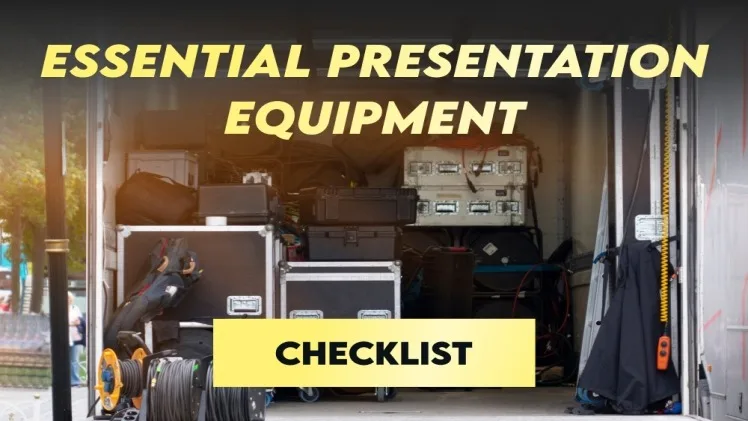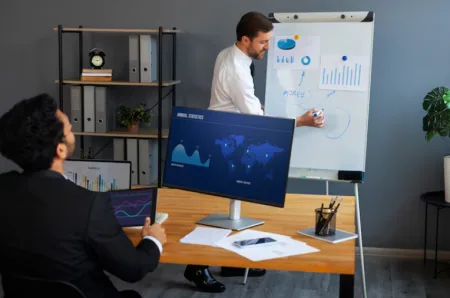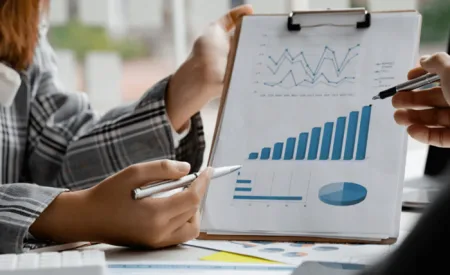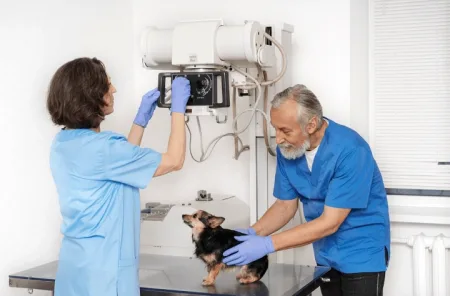In our busy world, having the right equipment for presentations is super important to communicate well. It doesn’t matter if you’re a grown-up or a student, being ready with the right tools can make your message awesome and get everyone interested.
Our comprehensive checklist covers the must-have equipment for both in-person and virtual presentations. From projectors to audio systems, discover how to amplify your message and leave a lasting impact.
Importance of Using Proper Presentation Equipment
When it comes to showing things with pictures and sound, it’s really important to use the right equipment. Having the right tools can make you look more professional, make people trust what you say, and make your presentation more successful.
- To have a successful presentation, you need the right equipment. It’s like building a strong base for a house. When you talk to people or show things, using good tools makes everything go smoothly. It’s like having a clear and colorful screen, good sound, and no technical problems. This way, people will pay attention to what you’re saying and won’t get bored.
- Enhancing Professionalism and Credibility: When you have really good presentation equipment, it shows that you take your job seriously and want to do a great job. It’s like having special tools that make you look professional and reliable. When you use these top-notch tools, people can see that you’re well-prepared and pay attention to even the smallest details. Whether you own the equipment or rent it, using high-quality visuals and sound makes your presentation look really polished and memorable. It’s like having a shiny badge that says you’re really good at what you do.
Must-Have Presentation Equipment
To make your audio visual presentation awesome, you need the right tools. We’ll give you a presentation equipment checklist of important things you should have.
These items will make your presentations even better. We’ll talk about projectors, laptops, clickers, and cables, and explain why they’re useful. We might also suggest some other options or give you advice.
Checklist of Essential Presentation Equipment:
Projector
A high-quality projector is a cornerstone of any audio-visual presentation. It allows you to display your content on a large screen, making it visible to the entire audience. Consider a projector with sufficient brightness and resolution to ensure clear and vibrant visuals.
Alternatives include portable projectors or even using a large TV screen if the venue permits. Projector and screen rental can help you with this.
Laptop
A reliable laptop is essential for storing and displaying your presentation slides. Opt for a model with sufficient processing power and storage capacity. Ensure it has compatible ports for connectivity with other devices. For those who prefer a lightweight option, consider a tablet with presentation capabilities or a hybrid laptop-tablet device.
Wireless Clicker
A wireless clicker is a cool gadget that helps you change slides without being stuck to your laptop. It’s like having a magic remote control. Find one that feels nice to hold and has easy buttons. If you don’t have a clicker, you can also use some special apps on your smartphone instead. It means you won’t need another device to control your slides.
Cables and Adapters
Having different cables, adapters, and docking stations is really important. They help you connect different devices together seamlessly. For example, HDMI, VGA, and USB-C cables are often used to connect laptops to projectors or screens. Sometimes you might need an adapter to make devices with different ports work together. In this regard, look here for options like an HP laptop docking station or one from another reputable brand to streamline your presentation setup even further. It’s like having special tools that let you connect things that don’t fit directly.
Audio Equipment
Depending on the size of your audience and the venue, audio equipment may be necessary to ensure clear and audible sound. Consider a portable speaker system or microphones for larger spaces. For virtual presentations, a good-quality headset or microphone can enhance the audio experience for remote attendees.
Audio-Visual Considerations
When you’re showing things to people, how they look and sound is really important. It’s like when you watch a movie or a cool video.
In this part, we’ll talk about why the things you see and hear are so important. We’ll also explain why having good sound is crucial for making a presentation that people will remember and really like.
The Significance of Audio-Visual Elements
Using cool things you can see and hear makes your presentation better. It’s like when you watch a movie with awesome pictures and great sound. In your presentation, you can use things like slides, videos, and pictures to help explain your ideas.
Audio visual presentation makes it easier for people to understand. At the same time, having clear and good sound makes your presentation more interesting and captures people’s attention. It’s like having a soundtrack that makes the story more exciting.
The Importance of Sound Quality
Having good sound is really important when you’re doing a presentation with things you can see and hear. Bad sound can make people not pay attention and make your message less powerful. To have great sound, think about using really good microphones or speakers.
If you’re speaking to a big group of people, having a special microphone, like one you hold or clip on your clothes, can make your voice louder and clearer.
And having good speakers can make the sound reach everyone in the room and make it feel like they’re inside the presentation. When you’re choosing sound equipment, remember these things:
- Venue Size: When you’re picking sound equipment, think about how big the place is where you’ll be doing your presentation. You want to make sure everyone can hear you well. If it’s a big room, you might need more powerful speakers so the sound reaches everyone. But if it’s a small room, you might not need such big speakers. It’s like using the right size of speakers for the right size of room, so everyone can hear you clearly.
- Virtual Presentations: Pay attention to the audio quality for remote participants. Use a good-quality headset or microphone to enhance the audio experience and minimize disruptions.
- Test and Adjust: Prior to your presentation, conduct thorough sound checks to identify any issues and adjust the volume levels accordingly. This ensures a seamless and uninterrupted flow of sound during your presentation.
Tailoring Presentation Equipment for Specific Audiences
To give a really good presentation, it’s important to know who you’re talking to and what they want. Different people, like businessmen, teachers, or students, have different things they expect and need.
In this part, we’ll talk about how you can choose the right presentation equipment for different types of audiences. This way, you can make sure they stay interested and really like what you’re saying.
Businessman and Agent
- Portable and lightweight equipment: When people in business need to travel to different places, it’s important to have equipment that’s easy to carry. Things like small projectors and thin laptops are great because they don’t take up much space and are light to carry. It’s like having things that can easily fit in a small bag and won’t make your luggage heavy. So, it’s easier to take them with you wherever you go!
- Wireless connectivity: People who work in business or as agents sometimes need to connect their devices, like laptops or phones, to big screens or projectors. They want to do this without any problems like things not working or getting stuck. Having wireless connectivity means they can connect their devices easily and make their presentations without any technical issues. It’s like having a special way to connect things without using any wires that can cause trouble.
Teacher and Student
- Interactive whiteboards or smartboards: Educators and students benefit from interactive presentation tools that allow them to engage with the content actively. Interactive whiteboards or smartboards enable collaboration, annotation, and dynamic visual displays.
- Document cameras: Teachers often need to display physical documents or objects. A document camera allows for real-time projection of these materials, making it easier to demonstrate concepts and engage the students effectively.
Event Planner
- Audiovisual systems for large venues: When event planners have to give presentations in big places, they use special equipment so everyone can see and hear everything well. They have really loud and clear speakers for sound, big screens for the pictures, and strong projectors that make the images really bright. It’s like having super powerful tools to make sure everyone in the big place can enjoy the presentation without any problems.
Sometimes, people who work in business or as agents need to show things from their devices on big screens. They want to do this easily, without any problems.
Wireless connectivity helps them connect their devices to screens or projectors without any wires. It’s like magic, making things work smoothly without any hassles.
Additional Tips for Successful Presentations
Besides having the right stuff for your presentation, there are some other things you can do to make it even better. In this part, we’ll give you some helpful ideas to make sure everything goes well.
By following these tips and making sure your setup is good, you’ll be ready to impress your audience and give a presentation they won’t forget. It’s like having some extra tricks up your sleeve to make your presentation super awesome.
Practical Tips for Successful Presentations
- Prepare Backup Files: Always have backup copies of your presentation files on multiple devices or cloud storage platforms. This ensures that you can access your content even if there are technical issues with your primary device.
- Arrive Early and Set Up: It’s a good idea to get to the place where you’ll be doing your presentation early. This way, you can look around and get used to the space. You’ll also have enough time to set up your equipment without feeling in a hurry. If there are any problems with the technology, you’ll have time to fix them. It’s like getting to a party early so you have time to get comfortable and make sure everything is ready.
- Practice with the Equipment: Before you do your presentation, practice using the equipment. Try out the clicker and see how it works. Test the projector and make sure the sound is good. Check that all the cables and connections are working properly. Doing this will help you feel more comfortable and sure of yourself when you actually do your presentation. It’s like practicing with your tools before a big game, so you know they work well.
- Double-Check Your Setup: Before you start your presentation, make sure everything is set up correctly. Check that all the equipment is connected the right way and that you’ve adjusted the settings how you like them. Make sure your slides, videos, and other things you want to show are appearing on the screen correctly. Also, check that the sound is working as it should. It’s like making sure everything is good to go before you start so there are no surprises. Never forget about this on your presentation checklist.
Elevate Your Presentations with the Right Equipment and Preparation
To make your presentation really awesome, you need to have the right visual presentation tools and follow some helpful tips. It’s like having a secret recipe for success! By using the checklist we gave you and following the tips, you’ll look more professional, make people trust you, and be really good at presenting.
It’s also important to use things that your audience will like. For example, if you’re talking to businessmen or teachers, use things that they’ll find interesting. And don’t forget about sound quality and using pictures and videos in a cool way.
RentForEvent can help you get all the things you need to make your presentation amazing. So, get ready to impress your audience and give them an experience they won’t forget!



